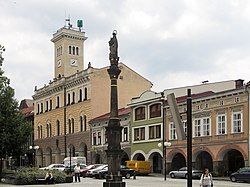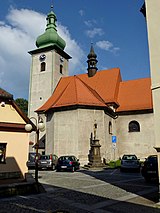Frenštát pod Radhoštěm
Frenštát pod Radhoštěm | |
|---|---|
 Town hall at the Míru Square | |
| Coordinates: 49°32′54″N 18°12′39″E / 49.54833°N 18.21083°E | |
| Country | |
| Region | Moravian-Silesian |
| District | Nový Jičín |
| First mentioned | 1382 |
| Government | |
| • Mayor | Jan Rejman |
| Area | |
• Total | 11.43 km2 (4.41 sq mi) |
| Elevation | 401 m (1,316 ft) |
| Population (2024-01-01)[1] | |
• Total | 10,676 |
| • Density | 930/km2 (2,400/sq mi) |
| Time zone | UTC+1 (CET) |
| • Summer (DST) | UTC+2 (CEST) |
| Postal code | 744 01 |
| Website | www |
Frenštát pod Radhoštěm (Czech pronunciation: [ˈfrɛnʃtaːt ˈpod radɦoʃcɛm]; German: Frankstadt (unter dem Radhoscht)) is a town in Nový Jičín District in the Moravian-Silesian Region of the Czech Republic. It has about 11,000 inhabitants. The historic town centre is well preserved and is protected by law as an urban monument zone.
Geography
Frenštát pod Radhoštěm is located about 15 kilometres (9 mi) southeast of Nový Jičín and 27 km (17 mi) south of Ostrava. It lies mostly in the Moravian-Silesian Foothills. The western part of the municipal territory extends into the Moravian-Silesian Beskids and contains the highest point of Frenštát pod Radhoštěm, the hill Vlčina at 532 m (1,745 ft) above sea level. The mountain of Radhošť, contained in the name of the town, is located south of the town outside the municipal territory. The town is situated at the confluence of the Lomná and Lubina rivers.
History

The first written mention of Frenštát is from 1382. It was probably founded during the colonization between 1293 and 1316. In 1473, it was first referred to as a market town. In the 16th century, it became a prosperous market town with developed trade and handicrafts.[2][3]
The Thirty Years' War affected the town severely as it was burned down in 1626, and occupied by the Swedes in 1646. The plague epidemic also affected Frenštát. In the 17th century, the economy grew, possibly due to being colonized by the Wallachians. In 1781, Frenštát was promoted to a town. [2]
In the second half of the 19th century, the industrialization occurred. Weaving switched to mechanical factory production, other important industries were dyeing, hosiery and the production of bentwood furniture. The development was supported by the opening of the railway in 1888. In 1921, Frenštát was renamed Frenštát pod Radhoštěm. The development ended with the World War II as the town was occupied by the Axis, but was liberated on 6 May 1945. After the war there was an extensive housing construction.[2][3]
Demographics
|
|
| ||||||||||||||||||||||||||||||||||||||||||||||||||||||
| Source: Censuses[4][5] | ||||||||||||||||||||||||||||||||||||||||||||||||||||||||
Transport
The I/58 road from Ostrava to Rožnov pod Radhoštěm passes through the town.
Frenštát pod Radhoštěm is located on the railway lines Ostrava–Frenštát pod Radhoštěm and Valašské Meziříčí–Frýdlant nad Ostravicí.[6]
Sport
Frenštát pod Radhoštěm is known as a ski centre. There is a complex with four ski jumps.[7]
Frenštát pod Radhoštěm is home to the football team SK Beskyd Frenštát pod Radhoštěm, which competes in lower amateur tiers.[8]
Sights

The town square is lined by preserved burgher houses. The landmark of the square is the two-storey Neorenaissance town hall. It was built in the Italianizing spirit in 1889–1891 on the site of an older town hall from 1796, and has an accessible tower. The interior is decorated by several valuable sculptures, including the original of the sculpture of Slavic god Radegast, created by Albin Polasek in 1929 and originally placed on Radhošť.[7][9]
The Church of Saint Martin was built in the early Baroque style in 1661. The Baroque chapels of St. Barbara and St. John of Nepomuk were added in around 1740.[10]
The boys' middle-class school from 1876 was the second Czech school in Moravia. Today the building is a cultural monument and houses the town museum.[9]
A technical monument is a fruit dryer built according to the design of Dušan Jurkovič in 1899.[7]
Notable people
- Albin Polasek (1879–1965), Czech-American sculptor and educator
- Bohuslav Fiala (1890–1964), brigadier general
- Břetislav Bartoš (1893–1926), painter
- Záviš Kalandra (1902–1950), historian and theorist
- Zdeněk Parma (1925–2006), alpine skier
- Ladislav Adamec (1926–2007), politician, Prime Minister of Czechoslovakia in 1988–1989
- Jiří Raška (1941–2012), ski jumper, Olympic winner
- Karel Loprais (1949–2021), rally raid driver; lived here
- Jiří Parma (born 1963), ski jumper
- Iveta Bartošová (1966–2014), singer; grew up here
Twin towns – sister cities
Frenštát pod Radhoštěm is twinned with:[11]
 Harrachov, Czech Republic
Harrachov, Czech Republic Krásno nad Kysucou, Slovakia
Krásno nad Kysucou, Slovakia La Grange, United States
La Grange, United States Ustroń, Poland
Ustroń, Poland
Gallery
-
Míru Square
-
Church of Saint John the Baptist
-
Train station
References
- ^ "Population of Municipalities – 1 January 2024". Czech Statistical Office. 2024-05-17.
- ^ a b c "Historie města" (in Czech). Tourist Information Centre Frenštát pod Radhoštěm. Retrieved 2022-02-14.
- ^ a b "Statut a jméno města" (in Czech). Tourist Information Centre Frenštát pod Radhoštěm. Retrieved 2022-02-14.
- ^ "Historický lexikon obcí České republiky 1869–2011" (in Czech). Czech Statistical Office. 2015-12-21.
- ^ "Population Census 2021: Population by sex". Public Database. Czech Statistical Office. 2021-03-27.
- ^ "Detail stanice Frenštát p.Radhoštěm" (in Czech). České dráhy. Retrieved 2024-05-20.
- ^ a b c "Frenštát pod Radhoštěm" (in Czech). CzechTourism. Retrieved 2022-02-14.
- ^ "Hlavní strana" (in Czech). SK Beskyd Frenštát pod Radhoštěm. Retrieved 2022-02-14.
- ^ a b "Měšťanské domy" (in Czech). Tourist Information Centre Frenštát pod Radhoštěm. Retrieved 2022-02-14.
- ^ "Karta NKP – kostel svatého Martina" (in Czech). Město Frenštát pod Radhoštěm. Retrieved 2022-02-14.
- ^ "Partnerské vztahy města" (in Czech). Město Frenštát pod Radhoštěm. Retrieved 2022-02-14.
External links





